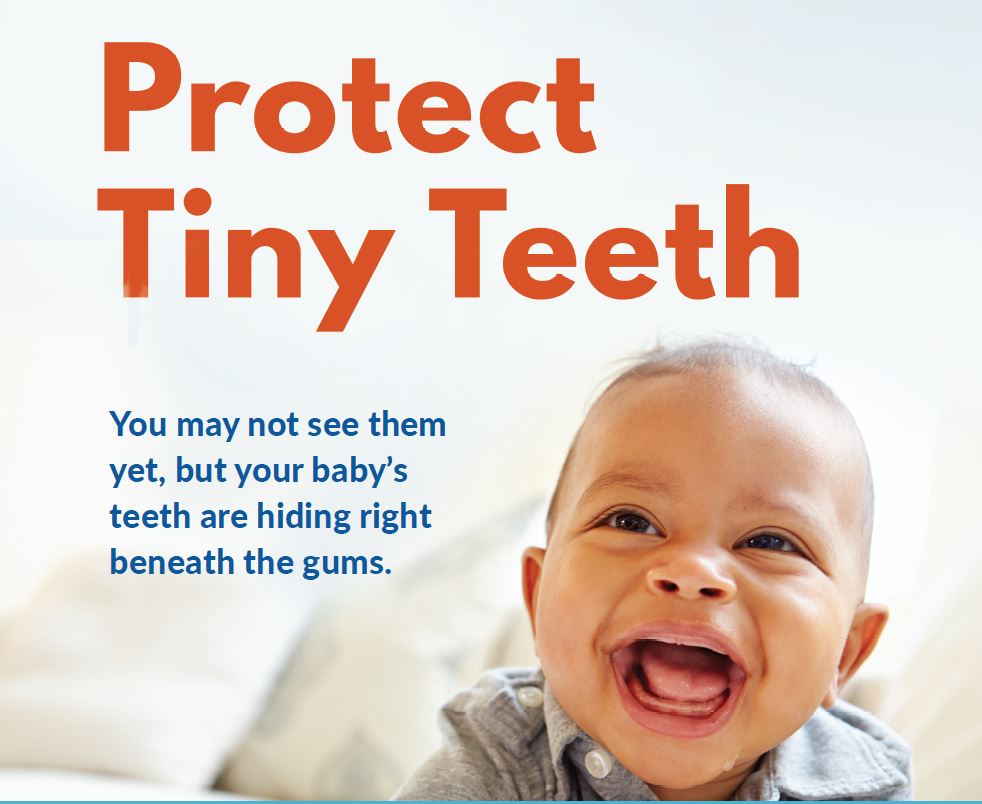Key points
- Dental care is safe and important during pregnancy.
- Protect Tiny Teeth is a set of resources to help healthcare providers talk to their pregnant patients and new parents about the importance of oral health.

Why it matters
One way to prevent cavities in young children is to improve pregnant women’s oral health. Pregnancy may make women more prone to periodontal (gum) disease and cavities. Oral health is important part of prenatal care, given that poor oral health during pregnancy can lead to poor health outcomes for the mother and baby.
Background

Oral health during pregnancy and infancy is especially important to set children up for a lifetime of good health. Pregnant patients and new parents want to know how to keep themselves and their babies happy and healthy.
In 2019, CDC and the American Academy of Pediatrics (AAP) launched Protect Tiny Teeth. This initiative has resources to help health care professionals talk with their pregnant patients about their oral health care needs. The toolkit also offers resources for pregnant women and new parents to promote good oral health during pregnancy and infancy.
Starting the conversation
Prenatal care providers play a crucial role in screening pregnant patients for chronic and acute oral health conditions. They can educate these patients on the significance of oral health for their families and refer them to dental professionals.
Pediatricians, given their frequent interactions with patients and caregivers during infancy, also have regular opportunities to offer preventive oral health services.
Explore the ways providers can use this toolkit
The Protect Tiny Teeth toolkit includes a mix of attention-grabbing materials to spark awareness that oral health should be part of prenatal care. It also offers tips on how to protect the oral health of infants.
Resources are included for medical providers and community liaisons, such as infographics and brief videos with tips on how to reach the intended audience. The materials are designed to help assess the needs of women, caregivers, and young children. The toolkit also provides talking points for a conversation about oral health and resources the patient can take home.
This toolkit is accessible in eight languages: English, Spanish, Arabic, Cambodian, French, Korean, Russian, and Taiwanese.
Pregnancy and Oral Health
Pregnancy and Periodontal (Gum) Disease
About 60% to 75% of pregnant women have gingivitis, an early stage of periodontal disease. Gingivitis occurs when the gums become red and swollen from inflammation that may be aggravated by changing hormones during pregnancy.1 If gingivitis is not treated, the bone that supports the teeth can be lost, and the gums can become infected. Teeth with little bone support can become loose and may eventually need to be extracted. Periodontitis has also been associated with poor pregnancy outcomes, including preterm birth and low birth weight.2 However, how periodontitis may lead to adverse pregnancy outcomes is not yet fully understood.
Pregnancy and Cavities
Pregnant women may also be at risk for cavities due to changes in behaviors, such as eating habits.3 Women with a lot of cavity-causing bacteria during and after pregnancy could transmit these bacteria from their mouth to the mouth of their baby.4 Early contact with these bacteria and other sugars, such as from frequent snacking or taking a bottle to bed, can lead to early childhood cavities and the need for extensive dental care at a young age.
- One in four women of childbearing age have untreated cavities.5
- Children of mothers with high levels of untreated cavities or tooth loss are more than 3 times more likely to have cavities as a child.6
- Children with poor oral health status are nearly 3 times more likely to miss school because of dental pain.7
Resources to share
Additional resources and information are available at:
- American Academy of Pediatrics, Protect Tiny Teeth Toolkit for Pregnant and New Moms
- American Academy of Pediatrics, Protect Tiny Teeth Toolkit for Providers
- American Dental Association Council on Access, Prevention, and Interprofessional Relations, 2006. Accessed November 21, 2023. https://ebusiness.ada.org/Assets/docs/2313.pdf
- Corbella S, Taschieri S, Del Fabbro M, Francetti L, Weinstein R, Ferrazzi E. Adverse pregnancy outcomes and periodontitis: a systematic review and meta-analysis exploring potential association. Quintessence Int. 2016;47(3):193–204. doi: 10.3290/j.qi.a34980
- Romero BC, Chiquito CS, Elejalde LE, Bernadoni CB. Relationship between periodontal disease in pregnant women and the nutritional condition of their newborns. J Periodontol. 2002;73:1177–1183. doi: 10.1902/jop.2002.73.10.1177
- Azofeifa A, Yeung LF, Alverson CJ, Beltrán-Aguilar E. Dental caries and periodontal disease among U.S. pregnant women and nonpregnant women of reproductive age, National Health and Nutrition Examination Survey, 1999–2004. J Public Health Dent. 2016;76:320–329. doi:10.1111/jphd.12159
- Lindquist B, Emilson CG. Colonization of Streptococcus mutans and Streptococcus sobrinus genotypes and caries development in children to mothers harboring both species. Caries Res. 2004;38(2):95–103. doi: 10.1159/000075932
- Dye BA, Vargas CM, Lee JJ, Magder L, Tinanoff N. Assessing the relationship between children's oral health status and that of their mothers. J Am Dent Assoc. 2011;142(2), 173–183. doi:10.14219/jada.archive.2011.0061
- Jackson SL, Vann WF, Kotch JB, Pahel BT, Lee JY. Impact of poor oral health on children's school attendance and performance. Am J Public Health. 2011;101:1900–1906. doi: 10.2105/AJPH.2010.200915
